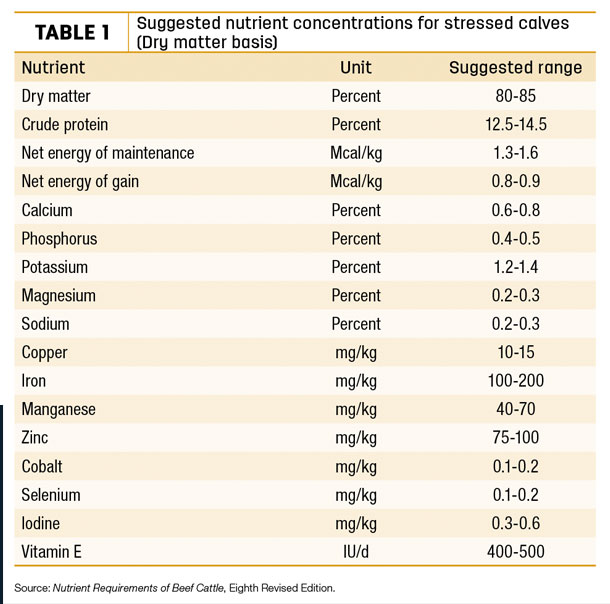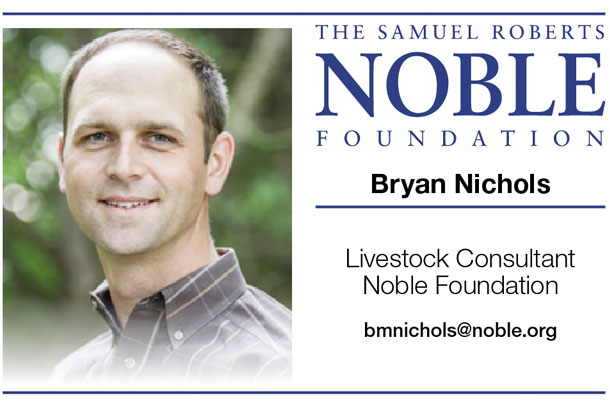Within this publication is a chapter devoted entirely to the effects of stress on beef cattle nutrient requirements, the chief instigator of stress being the weaning and marketing process. Providing adequate nutrition to high-risk calves is a critical component of a successful receiving program.
The primary hurdle of nutrition in the receiving period is depressed feed intake.
The classic literature that characterizes this is from research where 18 studies over the course of five years were summarized. These studies encompassed 690 head of calves with an average weight of 463 pounds. These cattle were sourced from the southeastern U. S. and received at Bushland, Texas.
Average feed consumption in the first seven days after arrival was 1.55 percent of bodyweight. Average feed consumption in the first 14 days after arrival was 1.9 percent of bodyweight. Intakes became much more “normal” when averaged over days 0 to 28 at 2.71 percent of bodyweight.
This data, along with others, drive the nutrient concentrations that the committee developed for feeding stressed calves (Table 1).

Many stocker producers will offer hay free-choice and limit-feed a grain and/or byproduct supplement. The nutrient concentrations in Table 1 are for the entire diet, not just the supplement being fed. Let’s look at an example of feeding a 450-pound steer during the first week of receiving.
Many starter rations that are commercially available are formulated at approximately 14 percent crude protein. Looking at Table 1, the crude protein concentration needed for the diet is 12.5 to 14.5 percent. Using the average of 13.5 percent protein at 1.55 percent of bodyweight intake, that is a requirement of 0.94 pounds of protein. If a supplement intake of 0.75 percent of bodyweight (3.4 pounds) is achieved during the first week of receiving, the supplement provides 0.48 pounds of protein.
This leaves 0.46 pounds of protein to be provided by the hay. With hay intake at 3.6 pounds and 0.46 pounds of protein needed, this means the hay needs to be 12.8 percent crude protein to meet the suggested requirements. The suggested nutrient concentrations are not aimed to provide high gains but rather to just maintain weight while intakes are extremely low. This example highlights the need for very good quality hay to be provided to high-risk calves at receiving.
There were a couple of changes made from the prior edition that would be of interest to stocker producers. One is the recommended amount of vitamin E to be offered to high-risk cattle. The prior recommendation was inclusion of 34 to 45 international units per pound of feed. The current edition increased this amount slightly and now expresses it on a per-day basis rather than as a concentration. The current recommendation is now 400 to 500 international units of vitamin E per day.
Another change made is an update to the maximum tolerable concentration of sulfur in the diet. This is of importance to stocker producers as there are large quantities of byproducts, mainly dried distillers grains and corn gluten feed, which are relatively high in sulfur. Previously, this level was 0.4 percent. The current edition updates this value to a range of 0.3 to 0.5 percent.
This is based on a recommendation made in the 2005 National Research Council publication of Mineral Tolerance of Animals. Sulfur tolerance is driven by the type of diet the animal is being fed.
Cattle fed a diet of greater than 85 percent concentrate have a sulfur limit of 0.3 percent, whereas cattle fed a diet of greater than 40 percent forage have a higher tolerable sulfur concentration of 0.5 percent. It is important to remember that water can be a significant source of sulfur consumption and should be included when developing rations.
The Nutrient Requirements of Beef Cattle is an excellent source of information that can be utilized by all in the beef industry. There is significant time and effort that goes into assimilating relevant data that can be formed into actionable recommendations. We are fortunate that this time and effort helps us provide optimal nutrition and be good caretakers of our livestock. ![]()
References omitted but are available upon request. Click here to email an editor.








